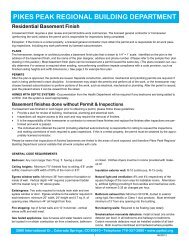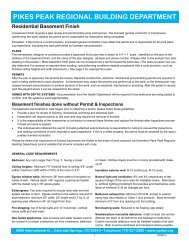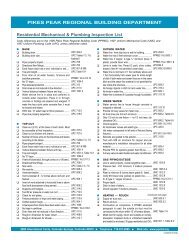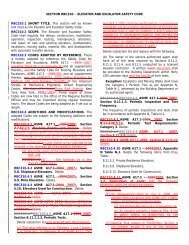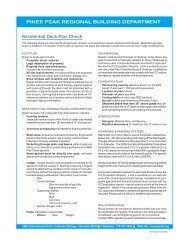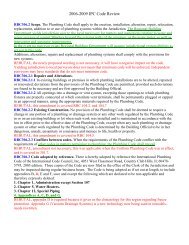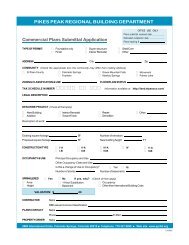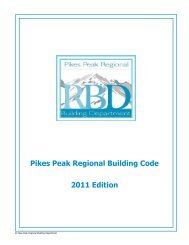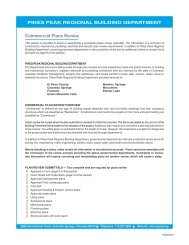Guidelines for Wiring Single Family Dwelling Units - Pikes Peak ...
Guidelines for Wiring Single Family Dwelling Units - Pikes Peak ...
Guidelines for Wiring Single Family Dwelling Units - Pikes Peak ...
You also want an ePaper? Increase the reach of your titles
YUMPU automatically turns print PDFs into web optimized ePapers that Google loves.
PIKES PEAK REGIONAL BUILDING DEPARTMENT<br />
<strong>Guidelines</strong> <strong>for</strong> <strong>Wiring</strong> <strong>Single</strong> <strong>Family</strong> <strong>Dwelling</strong> <strong>Units</strong><br />
<strong>Wiring</strong> must comply with the 2008 National Electrical Code (NEC), a code that is neither intended as a design specification nor instruction manual <strong>for</strong><br />
untrained individuals. Its purpose is the practical safeguarding of persons and properties from hazards arising from the use of electricity. This handout<br />
is an overview of the NEC requirement <strong>for</strong> single family dwellings. The in<strong>for</strong>mation does not cover requirements <strong>for</strong> every installation; it is to be used<br />
along with the NEC book.<br />
Inspections<br />
Review the following in<strong>for</strong>mation to understand what work needs to be completed be<strong>for</strong>e requesting inspections.<br />
ROUGH INSPECTION - All wire must be pulled, stapled properly, and all<br />
splices made and ready to accept devises and fixtures. Do not install any<br />
devices or fixtures or cover any wiring with insulation or wall covering,<br />
such as drywall or paneling, prior to the rough-in inspection.<br />
FINAL INSPECTION - The electrical installation must be complete when<br />
you request the final inspection. All devises and fixtures must be installed<br />
and service equipment complete and labeled properly. All wiring must be<br />
free from short circuits, ground fault and open circuits. All light fixtures<br />
and light switches must be grounded. All kitchen cabinets must be installed.<br />
Service<br />
The service equipment must be large enough to supply the connected load which is calculated using NEC Article 220. The most common sizes of<br />
residential service equipment or 100, 110, 125, 150, and 200 amperes. The minimum wire size <strong>for</strong> service entrance conductors are listed below. The<br />
service equipment must be grounded in accordance with NEC Article 250. The neutral must be bonded to the service enclosure and the grounding<br />
electrode system defined in NEC Article 250-50.<br />
The main service panel must be mounted either outside or inside the dwelling as near as possible to the point of entrance of the service conductors to<br />
the structure.<br />
All service equipment and electrical panels must have a clear area of 30 inches wide and 36 inches deep in front of the equipment. This clear area<br />
must extend from the floor to ceiling with no intrusions from other equipment, cabinets, counters, pipes, appliances, etc. Service equipment/panels are<br />
NOT allowed in clothes closets or bathrooms, or over stairs.<br />
CONDUCTOR TYPES AND SIZES<br />
(RH - RHH - THHW - THW - THWN - THHN - XHHW - USE)<br />
Copper<br />
AWG<br />
Aluminum & Copper-Clad AL<br />
AWG<br />
Service Rating<br />
In Amps<br />
4 2 100<br />
3 1 110<br />
2 1/0 125<br />
1 2/0 150<br />
1/0 3/0 175<br />
2/0 4/0 200<br />
3/0 250 kcmil 225<br />
4/0 300 kcmil 250<br />
250 kcmil 350 kcmil 300<br />
350 kcmil 500 kcmil 350<br />
400 kcmil 600 kcmil 400<br />
2880 International Cr., Colorado Springs, CO 80910 • Telephone 719-327-2880 • www.pprbd.org<br />
2/29/2012
Grounding requirements<br />
The service equipment must be grounded to comply with the provisions of article 250 of the NEC, stating that the neutral must be bounded to the service<br />
enclosure and the grounding electrode system as defined in Article 250.50 of the NEC.<br />
250.50 Grounding Electrode System. All grounding electrodes as described in 250.52 that are present at each building or structure served shall be<br />
bonded together to <strong>for</strong>m the grounding electrode system. The grounding electrodes permitted in 250.52 are (1) metal underground water pipe, (2)<br />
metal frame of the building or structure, (3) concrete-encased electrode, (4) ground ring, (5) rod and pipe electrodes, (6) other listed electrodes, (7)<br />
plate electrodes, and (8) other local metal underground systems or structures.<br />
250.52 (A)(3) Concrete-encased Electrode. An electrode encased by a minimum of 2 inches of concrete located within and near the bottom of the<br />
concrete foundation or footing that is in direct contact with the earth, consisting of at least 20 feet of on or more bare or zinc galvanized or other electrically<br />
conductive coated steel rein<strong>for</strong>cing bars or rods of not less than 1/2 inch in diameter, or consisting of at least 20 feet of bare copper conductor not<br />
smaller than 4 AWG. Rein<strong>for</strong>cing bars are permitted to be bonded together by the usual tie wires or other effective means. (Refer to Eufer Grounding<br />
handout)<br />
In the main service equipment, the neutral and the equipment grounding conductors are bonded together; in sub-panels the neutral is isolated from the<br />
ground.<br />
Branch circuit wiring<br />
<br />
<br />
NM cable (Romex) is universally used in residential dwellings. NM<br />
cable must have a 90º conductor insulation rating designated by a<br />
“B” on the cable sheath<br />
NM-B #12 and #14 are used <strong>for</strong> lighting and general purpose receptacle<br />
circuits<br />
Do not mix wire sizes on the same branch circuit. If you begin<br />
a circuit with #12, the same size wire is used throughout.<br />
INSTALLATION OF NM CABLE (ROMEX) - Nm cable must be<br />
stapled within 12 inches of metal boxes, 8 inches of plastic boxes,<br />
and every 4 1/2 feet thereafter. Proper connectors must be used<br />
where NM cable enters metal cabinets, boxes or panel boards.<br />
<br />
<br />
<br />
<br />
#10/2 w/ground is commonly used <strong>for</strong> electric water heaters<br />
#10/3 w/ground is used <strong>for</strong> electric dryers<br />
#8/3 and #6/3 w/ ground is used <strong>for</strong> ranges and wall mounted ovens<br />
Type SER cable with an insulated neutral is permitted <strong>for</strong> electric<br />
ranges, wall ovens and dryers.<br />
Cables must be protected by over-current devices (circuit breakers) that<br />
do not exceed their rated amp capacity. Amp capacities <strong>for</strong> cable types<br />
are:<br />
COPPER NM CABLE<br />
SE & SER ALUMINUM CABLE<br />
15 amperes <strong>for</strong> #14 40 amperes <strong>for</strong> #8<br />
20 amperes <strong>for</strong> #12 50 amperes <strong>for</strong> #6<br />
Only two Romex are allowed in one Romex connector.<br />
When NM cable is installed parallel to framing members or in bored<br />
holes, if must be located at least 1 1/4 inches from the nearest<br />
edge of the framing member to avoid nails or screw from penetrating<br />
the cables. If this distance can’t be maintained, the cable must<br />
be protected by a steel plate or sleeve that is at least 1/16 inch<br />
thick. NEC 300-4(A).<br />
Cable or raceway-type wiring methods installed in a groove to be<br />
covered by wallboard, siding, paneling, carpeting, or similar finish<br />
must be protected. The cable or wiring must be shielded with a<br />
1/16 inch deep steel plate, sleeve or equivalent OR recessed 1 1/4<br />
inch deep <strong>for</strong> the full length of the groove in which the cable or<br />
raceway is installed.<br />
CEILING MOUNTED PADDLE FANS - Ceiling mounted paddle fan<br />
outlet boxes or outlet box systems used as the sole support must<br />
be listed and specified <strong>for</strong> this use by the manufacturer, and limited<br />
to support fans weighing 70 pounds or less. Boxed used to support<br />
fans weighing more than 35 pounds must be marked to show the<br />
maximum support weight. NEC 314.27(D).<br />
30 amperes <strong>for</strong> #10<br />
40 amperes <strong>for</strong> #8<br />
55 amperes <strong>for</strong> #6<br />
NOTE: AL SE & SER cable cannot be installed in thermal insulation<br />
or else the 60º chart must be used from NEC Table 310.16<br />
2/29/2012
Required branch circuits<br />
CENTRAL HEATING - Central heating equipment must be supplied by an<br />
individual branch circuit.<br />
ARC FAULT PROTECTION - All 120-volt, single phase, 15 and 20 ampere<br />
branch circuits supplying outlets (lights, receptacles, smoke detectors)<br />
installed in dwelling unit family rooms, dining rooms, living rooms, parlors,<br />
libraries, dens, bedrooms, sunrooms, recreation rooms, closets, hallways, and similar<br />
rooms or areas must be protected by a listed arc-fault circuit interrupter,<br />
combination type to protect the branch circuit.<br />
GENERAL LIGHTING BRANCH CIRCUITS - Circuits must be computed<br />
on a three watts per foot basis. Up to 500 square feet of living area may<br />
be wired on a 15 ampere branch circuit or up to 640 square feet on a 20<br />
ampere circuit. These branch circuits may supply lighting outlets in all<br />
areas of the dwelling and receptacle outlets other than those described in<br />
the following paragraphs of this section.<br />
BATHROOM - A minimum of one 20-amp circuit <strong>for</strong> bathroom receptacle<br />
outlets must be supplied and not be used <strong>for</strong> other outlets. Exception:<br />
where a 20 ampere circuit supplies a single bathroom, outlets <strong>for</strong> other<br />
equipment within the same bathroom may be supplied in compliance with<br />
NEC 210.11(C)(3) exception. This circuit CANNOT be used <strong>for</strong> a whirlpool<br />
or hot tub.<br />
SMALL APPLIANCE BRANCH CIRCUITS - A minimum of two 20 ampere<br />
branch circuits are required to feed receptacle outlets <strong>for</strong> small appliance<br />
loads, including refrigeration equipment in the kitchen, pantry, breakfast<br />
room, and dining room. These circuits, whether two or more are<br />
used, CANNOT feed anything other than the receptacle in these areas.<br />
Lighting outlets and built-in appliances, such as garbage disposals, dishwashers,<br />
and trash compactors, are NOT permitted on these circuits.<br />
Kitchen counter top receptacles must be supplied by at least two small<br />
appliance branch circuits. Exception: The receptacle outlet <strong>for</strong> refrigeration<br />
equipment is permitted to be supplied from an individual branch circuit<br />
rated 15 amperes or greater.<br />
LAUNDRY BRANCH CIRCUITS - A single 20 amp branch circuit must be<br />
provided <strong>for</strong> the laundry. This circuit is limited to receptacles within the<br />
laundry room. No other outlets are permitted in this circuit.<br />
Receptacle outlets<br />
BASEMENT - At least one receptacle must be installed in each unfinished<br />
basement. This receptacle is in addition to any that may be installed <strong>for</strong><br />
laundry purposes or their specific purpose.<br />
BATHROOMS - At least one outlet will be installed within 36 inches of the<br />
outside edge of each basin. The receptacle outlet will be located on a wall<br />
that is adjacent to the basin.<br />
FLOOR RECEPTACLES - Receptacles installed in the floor must use a<br />
box-receptacle combination designed specifically <strong>for</strong> that purpose. If installed<br />
in the floor within 18 inches of the wall, it may be used in place of<br />
wall mounted receptacles.<br />
HALLWAY - A receptacle outlet is required in any dwelling unit hallway<br />
that is 10 feet or more in length.<br />
HEATING, AC, REFREGERATION EQUIPMENT - A 125 volt, 15 or 20<br />
ampere receptacle outlet must be installed at an accessible location <strong>for</strong><br />
servicing of this equipment. The outlet must be located on the same level<br />
and within 25 feet of equipment, including those mounted on the roof.<br />
Exception: evaporative coolers.<br />
KITCHEN AND DINING COUNTERTOP - A receptacle outlet must be<br />
installed at each counter space 12” or wider. Receptacles will be installed<br />
so that no point along the wall line is more than 24 inches measured horizontally<br />
<strong>for</strong>m a receptacle outlet in that space. Peninsular bars and islands<br />
12” wide or greater must have a minimum of one receptacle.<br />
ROOMS - In every kitchen, family room, dining room, living room, parlor,<br />
library, den, sun room, bedroom, recreation room, or similar room of a<br />
dwelling unit, receptacle outlets must be installed so that no point along<br />
the floor line in any wall space is more than six feet horizontally, from an<br />
outlet in that space, two feet or more in width, and excluding only that<br />
space occupied by sliding panels in exterior walls. The wall space af<strong>for</strong>ded<br />
by fixed room divider, such as freestanding bar type counter, will be<br />
included in the six foot measurement. No outlet may be installed over an<br />
electric baseboard heater.<br />
GARAGES - At least one outlet must be installed in each attached garage,<br />
and one in each detached garage with electric power.<br />
OUTDOOR OUTLETS - At least two outlets must be installed outdoors,<br />
one in front and one in back of the dwelling, and be accessible at grade<br />
level. When installed in wet locations, a weatherproof enclosure is required<br />
whether or not the attachment plug cap is inserted.<br />
Lighting Outlets<br />
COMMON LOCATION REQUIREMENTS - At least one wall switch controlled<br />
lighting outlet must be installed in every habitable room, bathrooms,<br />
hallways, stairways, attached garages, detached garages with electric<br />
power, and outdoor entrances or exits. The lighting outlet <strong>for</strong> interior stairways<br />
will have a wall switch at each floor level where the difference between<br />
floor levels is six steps or more.<br />
STORAGE AND EQUIPEMENT AREAS - At least one wall switch controlled<br />
lighting outlet shall be installed in an attic, under-floor space, utility<br />
room and basement where these spaces are used <strong>for</strong> storage or contain<br />
equipment that requires servicing. The switch must be located at the point<br />
of entry to the area and the lighting outlet located at or near the equipment<br />
that requires servicing.<br />
Ground fault protection<br />
Receptacles required to be protected by a ground fault interrupter:<br />
Bathroom receptacles<br />
All outdoor receptacles<br />
Kitchen receptacles that serve counter top surfaces<br />
Receptacles within 6 fee of a wet bar, laundry, or utility sink<br />
Hydro massage bath tubs<br />
Spas and hot tubs and associated components<br />
Garage and accessory building with a floor located at or below<br />
grade level, not intended as habitable rooms and limited to storage<br />
or work areas<br />
All receptacles in an unfinished basement or crawl space at or below<br />
grade<br />
2/29/2012
Conductor fill<br />
Outlet and junction boxes must be of sufficient size to provide free space <strong>for</strong> all conductors and devices enclosed in the box. All outlet boxes have a<br />
specific volume measured in cubic inches.<br />
EXAMPLE: Two #12/2 with ground NM-B cable entering a box with one duplex receptacle require a box with a minimum volume of 15.75 cubic inches.<br />
Each #12 that enters the box needs 2.25 cubic inches with the exception of the grounding conductor that requires one 2.25 cubic inch <strong>for</strong> one or all. In<br />
addition, each strap containing one or more devices is counted as the equivalent of two conductors: 2.25 x 7 = 15.75<br />
Volume allowance required per conductor<br />
#14 = 2 cubic inches<br />
#12 = 2.25 cubic inches<br />
#10 = 2.5 cubic inches<br />
#8 = 3 cubic inches<br />
#6 = 5 cubic inches<br />
Equipment grounding conductors<br />
All equipment grounding conductors must be connected together with solder-less pressure connectors such as wire nuts or crimp sleeves, leaving<br />
sufficient extra conductor <strong>for</strong> attachment to the metal box and/or device. When crimp type connectors are used, they must be crimped using the tool<br />
recommended by the manufacturer. NOTE: All metal junction and outlet boxes must be grounded by attaching the equipment grounding conductor<br />
out of the NM cable to the metal box using an approved screw or grounding clip.<br />
Be<strong>for</strong>e circuit conductors are made up, three inches of free conductor measured from the front of the box must be left <strong>for</strong> use in make-up and <strong>for</strong> the<br />
attachment of devices.<br />
Disconnecting means<br />
Disconnects are required in sight of the following:<br />
Electric hot water heaters<br />
Well pump controllers<br />
Central heating equipment (furnaces, boilers, etc.)<br />
Spas and hot tubs<br />
Hydro massage bathtubs<br />
Appliances<br />
Electric heat circuitry<br />
Electric heat must be installed on 15, 20, or 30 amp branch circuits.<br />
Listed below is the maximum wattage that may be installed on each size<br />
branch circuit.<br />
15A =<br />
20A =<br />
30A =<br />
2880 watts maximum<br />
3840 watts maximum<br />
5760 watts maximum<br />
EXAMPLE: When installing a baseboard heater that is rated 250 watts<br />
per linear foot, you could install 15 feet on a 20 amp, 240 volt circuit:<br />
250w x 15 = 3750 watts.<br />
2/29/2012



